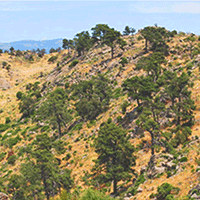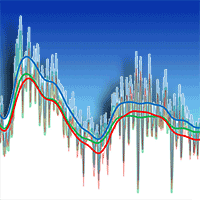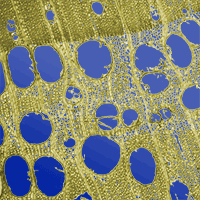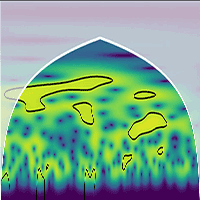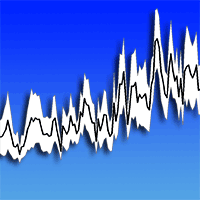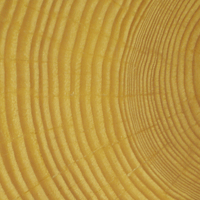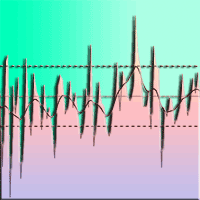We investigated whether there are significant differences in the climatic response of resin-tapped and untapped maritime pine (Pinus pinaster Ait.) trees in four forest stands in the central mountains of Spain, where the species is of natural origin. The stands are located in different provenance regions, with the westernmost site located on the northern slopes of Sierra de Gredos and the easternmost in the transition to the middle Duero basin, with altitudes ranging from 900 to 1350 m a.s.l. Dominant trees were sampled and standard dendrochronological methods were used to compare tree growth of both types of trees at each site. Climate-tree growth relationships were assessed using bootstrap correlations and response functions between tree-ring growth indices and climate variables, for both partials and full local chronologies of each stand, selecting climatic data from the most complete and closest meteorological stations. Our results showed that the trees selected for resin extraction were older, on average, and when site characteristics were favorable enough for maritime pine growth and resin extraction, all trees were resin-tapped. Contrastingly, when site characteristics were unfavorable for resin extraction, only the largest and the best-developed trees were tapped. No major differences were found between the climatic responses of resin-tapped and untapped trees, and it was therefore possible to use all the available tree-ring width series per site, both resin-tapped and untapped trees, to identify the main climatic drivers of maritime pine growth in central Spain. In addition, we have expanded the chronologies network of Pinus pinaster in Spain in number and length. This work may provide valuable information to improve forest management strategies for sustainable resin production.
Keywords
, , ,
Citation
Génova M, Caminero L, Gutiérrez E (2024). Contrasting resin-tapped and untapped Pinus pinaster Ait. trees of central Spain in a dendroclimatic research. iForest 17: 148-155. - doi: 10.3832/ifor4458-017
Academic Editor
Jesus Julio Camarero
Paper history
Received: Aug 24, 2023
Accepted: Feb 09, 2024
First online: May 30, 2024
Publication Date: Jun 30, 2024
Publication Time: 3.70 months
© SISEF - The Italian Society of Silviculture and Forest Ecology 2024
Open Access
This article is distributed under the terms of the Creative Commons Attribution-Non Commercial 4.0 International (https://creativecommons.org/licenses/by-nc/4.0/), which permits unrestricted use, distribution, and reproduction in any medium, provided you give appropriate credit to the original author(s) and the source, provide a link to the Creative Commons license, and indicate if changes were made.

Breakdown by View Type
(Waiting for server response...)
Article Usage
Total Article Views: 12578
(from publication date up to now)
Breakdown by View Type
HTML Page Views: 8653
Abstract Page Views: 1647
PDF Downloads: 2011
Citation/Reference Downloads: 2
XML Downloads: 265
Web Metrics
Days since publication: 579
Overall contacts: 12578
Avg. contacts per week: 152.07
Article Citations
Article citations are based on data periodically collected from the Clarivate Web of Science web site
(last update: Mar 2025)
Total number of cites (since 2024): 1
Average cites per year: 0.50
Publication Metrics
by Dimensions ©
Articles citing this article
List of the papers citing this article based on CrossRef Cited-by.
(1)
Abad R, Caudullo G, Oliveira S, De Rigo D (2016)Pinus pinaster in Europe: distribution, habitat, usage, and threats. In: “European Atlas of Forest Tree Species” (San-Miguel-Ayanz J, de Rigo D, Caudullo G, Houston T, Mauri A eds). Publication Office of the European Union, Luxembourg, pp. 128-129.
Gscholar
(2)
Alcalde C, García-Amorena I, Gómez-Manzaneque F, Maldonado J, Morla C, Postigo JM, Rubiales JM, Sánchez L (2004)Nuevos datos de carbones y maderas fósiles de
Pinus pinaster Aiton en el Holoceno de la Península Ibérica [New data on charcoals and fossil woods of
Pinus pinaster Aiton in the Holocene of the Iberian Peninsula]. Investigación Agraria - Sistemas y Recursos Forestales Fuera de serie 15: 2-163. [in Spanish]
Gscholar
(3)
Alía R, Martín S, De Miguel J, Galera R, Agúndez D, Gordo J, Salvador L, Catalán G, Gil L (1996)Las regiones de procedencia de
Pinus pinaster Aiton [The regions of origin of
Pinus pinaster Aiton]. Ministerio de Medio Ambiente, Madrid, Spain, pp. 75. [in Spanish]
Gscholar
(4)
Arzac A, Rozas V, Rozenberg P, Olano JM (2018)Water availability controls
Pinus pinaster xylem growth and density: a multi-proxy approach along its environmental range. Agricultural and Forest Meteorology 250: 171-180.
CrossRef |
Gscholar
(5)
Ballesteros JA, Stoffel M, Bodoque JM, Bollschweiler M, Hitz O, Díez-Herrero A (2010)Changes in wood anatomy in tree rings of
Pinus pinaster Ait. following wounding by flash floods. Tree Ring Research 66 (2): 93-103.
CrossRef |
Gscholar
(6)
Biondi F, Waikul K (2004)Dendroclim 2002: a C++ program for statistical calibration of climate signals in tree-ring chronologies. Computers and Geosciences 30: 303-311.
CrossRef |
Gscholar
(7)
Bogino SM, Bravo F (2008)Growth response of
Pinus pinaster Ait. to climatic variables in central Spanish forests. Annals of Forest Science 65 (5): 506-506.
CrossRef |
Gscholar
(8)
Camarero JJ, Gazol A, Tardif JC, Conciatori F (2015)Attributing forest responses to global change drivers: limited evidence of a CO2-fertilization effect in Iberian pine growth. Journal of Biogeography 42 (11): 2220-2233.
CrossRef |
Gscholar
(9)
Caminero L, Génova M, Camarero JJ, Sánchez-Salguero R (2018)Growth responses to climate and drought at the southernmost European limit of Mediterranean
Pinus pinaster forests. Dendrochronologia 48: 20-29.
CrossRef |
Gscholar
(10)
Campelo F, Vieira J, Nabais C (2013)Tree-ring growth and intra-annual density fluctuations of
Pinus pinaster responses to climate: does size matter? Trees 27: 763-772.
CrossRef |
Gscholar
(11)
Candel-Pérez D, Linares JC, Viñegla B, Lucas-Borja ME (2012)Assessing climate-growth relationships under contrasting stands of co-occurring Iberian pines along an altitudinal gradient. Forest Ecology and Management 274: 48-57.
CrossRef |
Gscholar
(12)
Carrión JS, Navarro C, Navarro J, Munuera M (2000)The distribution of cluster pine (
Pinus pinaster) in Spain as derived from palaeoecological data: relationships with phytosociological classification. The Holocene 10: 243-252.
CrossRef |
Gscholar
(13)
Chen F, Yuan YJ, Yu SL, Zhang TW (2015)Influence of climate warming and resin collection on the growth of Masson pine (
Pinus massoniana) in a subtropical forest, southern China. Trees 29: 1423-1430.
CrossRef |
Gscholar
(14)
Cook ER, Krusic PJ (2008)A tree-ring standardization program based on detrending and autoregressive time series modeling, with interactive graphics (ARSTAN). Tree-Ring Laboratory, Lamont-Doherty Earth Observatory, Columbia University, Palisades, NY, USA.
Gscholar
(15)
Correia I, Almeida MH, Aguiar A, Alía R, David TS, Pereira JS (2008)Variations in growth, survival and carbon isotope composition (δ13C) among
Pinus pinaster populations of different geographic origins. Tree Physiology 28 (10): 1545-1552.
CrossRef |
Gscholar
(16)
Da Silva KC, De Lima JC, Fett-Neto AG (2013)Oleoresins from pine: production and industrial uses. In: “Natural Products: Phytochemistry, Botany and Metabolism of Alkaloids, Phenolics and Terpenes” (Ramawat G, Mérillon JM eds). Springer, Berlin, Heidelberg, pp. 4037-4060.
Online |
Gscholar
(17)
Gea-Izquierdo G, Férriz M, García-Garrido S, Aguín O, Elvira-Recuenco M, Hernandez-Escribano L, Martin-Benito D, Raposo R (2019)Synergistic abiotic and biotic stressors explain widespread decline of
Pinus pinaster in a mixed forest. Science of the Total Environment 685: 963-975.
CrossRef |
Gscholar
(18)
Génova M (2000)Anillos de crecimiento y años característicos en el Sistema Central (España) durante los últimos cuatrocientos años [Tree rings and pointer years in the Central System (Spain) over the last four hundred years]. Boletín de la Sociedad Española de Historia Natural (Sección Biología) 96 (1-2): 33-42. [in Spanish]
Gscholar
(19)
Génova M (2012)Extreme pointer years in tree-ring records of Central Spain as evidence of climatic events and the eruption of the Huaynaputina Volcano (Peru, 1600 AD). Climate of the Past 8: 751-764.
CrossRef |
Gscholar
(20)
Génova M, Caminero L, Dochao J (2014)Resin tapping in
Pinus pinaster: effects on growth and response function to climate. European Journal of Forest Research 133 (2): 323-333.
CrossRef |
Gscholar
(21)
Gómez-González C, Ruiz-Zapata B, Gil-García MJ, López-Sáez JA, Santiesteban J, Mediavilla R, Domínguez F, Vera S (2009)Evolución del paisaje vegetal durante los últimos 1680 años BP en el Macizo de Peñalara (Sierra de Guadarrama, Madrid) [Evolution of the vegetation landscape during the last 1680 years BP in the Peñalara Massif (Sierra de Guadarrama, Madrid)]. Revista Española de Micropaleontología 41: 75-89. [in Spanish]
Gscholar
(22)
Holmes RL (1999)Users manual for program COFECHA. Laboratory of Tree-Ring Research, University of Arizona, Tucson, NM, USA.
Gscholar
(23)
Kurz-Besson CB, Lousada JL, Gaspar MJ, Correia IE, David TS, Soares PM, López-Sáez López-Merino JA L, Alba-Sánchez F, Pérez-Díaz S, Abel-Schaad D, Carrión JS (2010)Late Holocene ecological history of
Pinus pinaster forests in the Sierra de Gredos of central Spain. Plant Ecology 206: 195-209.
CrossRef |
Gscholar
(24)
Madrigal-González J, Andivia E, Zavala MA, Stoffel M, Calatayud J, Sánchez-Salguero R, Ballesteros-Cánovas J (2018)Disentangling the relative role of climate change on tree growth in an extreme Mediterranean environment. Science of the Total Environment 642: 619-628.
CrossRef |
Gscholar
(25)
Magnuszewski M, Tomusiak R (2013)Effect of resin-tapping on the radial increment of Scots pine (
Pinus sylvestris L.) - Case study of a stand from Lidzbark forest district. Forest Research Papers 74 (3): 273-280.
CrossRef |
Gscholar
(26)
Morales-Molino C, García-Antón M, Postigo-Mijarra JM, Morla C (2013)Holocene vegetation, fire and climate interactions on the westernmost fringe of the Mediterranean Basin. Quaternary Science Reviews 59: 5-17.
CrossRef |
Gscholar
(27)
Navarro-Cerrillo R, Rodriguez-Vallejo C, Silveiro E, Hortal A, Palacios-Rodríguez G, Duque-Lazo J, Camarero J (2018)Cumulative drought stress leads to a loss of growth resilience and explains higher mortality in planted than in naturally regenerated
Pinus pinaster stands. Forests 9 (6): 358.
CrossRef |
Gscholar
(28)
Olmedo-Cobo JA, Cunill-Artigas R, Gómez-Zotano J (2019)The native status of
Pinus pinaster on serpentine soils: charcoal analysis and palaeoenvironmental history in Sierra Bermeja (southern Iberian Peninsula, Spain). Vegetation History and Archaeobotany 28 (4): 417-432.
CrossRef |
Gscholar
(29)
Papadopoulos AM (2013)Resin tapping history of an aleppo pine forest in Central Greece. Open Science Journal 6: 50-53.
CrossRef |
Gscholar
(30)
Picardo A, Pinillos F (2013)La resinación en España y en el mundo en 2013: situación y perspectivas [Resin extraction in Spain and in the world in 2013: situation and perspectives]. In: Proceedings of the “II Simposio Internacional de Resinas Naturales”. Coca (Segovia, Spain) 16-18 Apr 2013. MAGRAMA, Madrid, Spain, pp. 30-53. [in Spanish]
Gscholar
(31)
Regato P, Génova M, Gómez-Manzaneque F (1992)Las representaciones relictas de
Pinus nigra Arnold en el Sistema Central español [The relict representations of
Pinus nigra Arnold in the Spanish Central System]. Boletín de la Sociedad Española de Historia Natural (Sección Biología) 88: 63-71. [in Spanish]
Gscholar
(32)
Rinn F (2003)TSAPWin, time series analysis and presentation for dendrochronology and related applications, version 0.53, user reference. Heidelberg, Germany, pp. 92.
Gscholar
(33)
Robles-López S, Pérez-Díaz S, Ruiz-Alonso M, Blarquez O, Luelmo-Lautenschlaeger R, López-Sáez JA (2020)Holocene vegetation and fire dynamics in the supra-Mediterranean belt of the Gredos Range (central Iberian Peninsula). Plant Biosystems 154 (1): 74-86.
CrossRef |
Gscholar
(34)
Rodríguez-Vallejo C, Navarro-Cerrillo RM (2019)Contrasting response to drought and climate of planted and natural
Pinus pinaster Aiton forests in Southern Spain. Forests 10 (7): 603.
CrossRef |
Gscholar
(35)
Rozas V, Zas R, García-González I (2011)Contrasting effects of water availability on
Pinus pinaster radial growth near the transition between the Atlantic and Mediterranean biogeographical regions in NW Spain. European Journal of Forest Research 130 (6): 959-970.
CrossRef |
Gscholar
(36)
Rubiales JM, García-Amorena I, Hernández L, Génova M, Martínez F, Gómez-Manzaneque F, Morla C (2010)Late Quaternary dynamics of pinewoods in the Iberian mountains. Review of Palaeobotany and Palynology 162 (3): 476-491.
CrossRef |
Gscholar
(37)
Rubio-Cuadrado A, Bravo-Oviedo A, Mutke S, Del Río M (2018)Climate effects on growth differ according to height and diameter along the stem in
Pinus pinaster Ait. iForest 11 (2): 237-242.
CrossRef |
Gscholar
(38)
Sánchez-Salguero R, Camarero JJ, Rozas V, Génova M, Olano JM, Arzac A, Gazol A, Caminero L, Tejedor E, De Luis M, Linares JC (2018)Resist, recover or both? Growth plasticity in response to drought is geographically structured and linked to intraspecific variability in
Pinus pinaster. Journal of Biogeography 45 (5): 1126-1139.
CrossRef |
Gscholar
(39)
Sánchez-Salguero R, Navarro RM, Camarero JJ, Fernández-Cancio A (2010)Drought-induced growth decline of Aleppo and maritime pine forests in south-eastern Spain. Forest Systems 19 (3): 458-470.
CrossRef |
Gscholar
(40)
Sánchez-Salguero R, Navarro-Cerrillo RM, Camarero JJ, Fernández-Cancio A (2012)Selective drought-induced decline of pine species in southeastern Spain. Climatic Change 113 (3-4): 767-785.
CrossRef |
Gscholar
(41)
Shigo AL (1984)Compartmentalization: a conceptual framework for understanding how trees grow and defend themselves. Annual Review of Phytopathology 22: 189-214.
CrossRef |
Gscholar
(42)
Schweingruber FH (1996)Tree rings and environment: dendroecology. Paul Haupt AG, Bern, Switzerland, pp. 609.
Online |
Gscholar
(43)
Soliño M, Yu T, Alía R, Auñón F, Bravo-Oviedo A, Chambel MR, De Miguel J, Del Río M, Justes A, Martínez-Jauregui M, Montero G, Mutke S, Ruiz-Peinado R, García Del Barrio JM (2018)Resin-tapped pine forests in Spain: ecological diversity and economic valuation. Science of the Total Environment 625: 1146-1155.
CrossRef |
Gscholar
(44)
Van Der Maaten E, Mehl A, Wilmking M, Van Der Maaten-Theunissen M (2017)Tapping the tree-ring archive for studying effects of resin extraction on the growth and climate sensitivity of Scots pine. Forest Ecosystems 4 (1): 7.
CrossRef |
Gscholar
(45)
Vieira J, Campelo F, Nabais C (2009)Age-dependent responses of tree-ring growth and intra-annual density fluctuations of
Pinus pinaster to Mediterranean climate. Trees 23 (2): 257-265.
CrossRef |
Gscholar
(46)
Zeng X, Sun S, Wang Y, Chang Y, Tao X, Hou M, Wang W, Liu X, Zhang L (2021)Does resin tapping affect the tree-ring growth and climate sensitivity of the Chinese pine (
Pinus tabuliformis) in the Loess Plateau, China? Dendrochronologia 65: 125800.
CrossRef |
Gscholar
